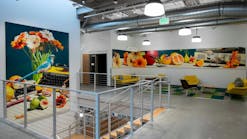The Auroralia Award has recognized a series of forward-thinking, sustainable, urban lighting schemes across the globe. First prize went to Ghent in Belgium, second place was awarded to Valença in Portugal, while the massive LED retrofit program in Los Angeles came third. The Chilean city of Buin received a special mention from the panel of independent judges composed of editors from the specialized press. Details of the winning projects can be found below.
The representatives of these four municipalities received their Auroralia Award on December 7 in Lyon, France, at the official ceremony that took place during the prestigious Lyon Light Festival.
In its fourth year, the Auroralia Award is organized jointly by LUCI and lighting manufacturer Schréder. Lighting Urban Community International (LUCI) is an international urban lighting network of cities with over 100 members, including 65 cities on 5 continents.
“Schréder supports the Auroralia Award because it fully reflects the values held by the Group,” explains Luc de Lamalle, Communication Director for the Schréder Group. “Developing innovative solutions that make it possible to achieve energy savings while enhancing the safety and well-being of users is the challenge that we have set for ourselves on a daily basis.”
For the 2012 Auroralia Award, 16 cities and towns from across the world submitted entries: Bogota, Colombia; Bucaramanga, Colombia; Buin, Chile; Ghent, Belgium; Guimarães, Portugal; Heilbronn, Germany; Lavagna, Italy; Leipzig, Germany; London, United Kingdom; Los Angeles, United States of America; Lyon, France; Reguengos de Monsaraz, Portugal; Soto del Real, Spain; Taxco de Alarcón, Mexico; Valença, Portugal and Valladolid, Spain.
Each of these municipalities submitted details of their outdoor lighting project. The judging criteria took into account the efforts to minimize the project’s environmental impact – quantified in particular by a reduction in CO2 emissions – as well as each project’s exemplary character, its integration within a larger plan, its socio-economic relevance, its educational dimension and its originality.
1st Prize - Ghent (Belgium)
With more than 250,000 inhabitants, Ghent is the second most populated municipality in Belgium and the country’s main student city. Wishing to be part of a sustainable development process, Ghent played a leading role on a national level in 1998 by launching a lighting plan. In 2005, the “Rational Use of Energy” project was launched. Through a continuous and reasonable investment, the Flemish city has gradually modernized its infrastructures to constantly reduce its energy needs. At the same time, it has ensured that its lighting installations are supplied with greener energy. Since 2008, the electricity used by the city is from 100% renewable sources.
Judges’ comments: The Auroralia Award judges were impressed by the perseverance of the city’s commitment. Thanks to its rational approach aimed at a targeted and gradual replacement of its lighting installations, it has reconciled strict financial management with high targets in reducing energy consumption and C02 emissions.
2nd Prize - Valença (Portugal)
A significant portion of the project consisted of completely renewing the lighting installations, the inefficiency of which impaired the town’s nocturnal ambiance. The old lanterns were replaced with Coroada luminaires, designed for the occasion by the architect Eduardo Souto de Moura, winner of the prestigious Pritzker Prize. Initially, the Coroada luminaires were fitted with metal-halide lamps, and in subsequent phases they were fitted with LED light engines. The Coroada, which perfectly blends into the urban landscape, combines a traditionally inspired aesthetic design with modern technology to provide Valença with a lighting installation that is in line with the architectural heritage while generating substantial energy savings. The Portuguese town has reduced its energy consumption by 69% and its CO2 emissions by over 28.5 tonnes per year.
Judges’ comments: This urban renewal project which has transformed the nocturnal life within the town was unanimously hailed by the press. The Auroralia judges joined in this overwhelming support by awarding the second prize to this Portuguese town.
3rd Prize - Los Angeles (United States of America)
With over 210,000 lighting points, Los Angeles possesses the second-largest lighting system in the United States. In February 2009, former President of the United States Bill Clinton, at the head of the Clinton Climate Initiative, and the Mayor of Los Angeles, Antonio Villaraigosa, launched a major plan for the conversion of 140,000 luminaires to LED technology. The first phase of the “Los Angeles LED Conversion Project” focused on modernizing the lighting of the residential areas and secondary roads with new luminaires fitted with 20 or 40 LEDs. The second phase of the place took place in the second half of 2012. It involved replacing the luminaires installed on the main roads with units fitted with 60 to 160 LEDs.
Today, with over 100,000 LED luminaires installed (another 38,000 will be installed in 2013), each generating 50% energy savings compared to the luminaire they have replaced, Los Angeles is reducing its CO2 emissions by no less than 29,500 tonnes per year! In California, 52% of the electricity consumed still comes from plants using fossil fuels (coal). The shift to LED lighting therefore has a very favourable impact on the carbon footprint.
Judges’ comments: By awarding the third prize to Los Angeles, the Auroralia jury was keen to highlight the driving role played by the Californian megalopolis in the search for greater energy efficiency in the United States.
Special Mention - Buin (Chile)
The first phase has already borne fruit with the new LED lighting installation of the city’s main square, the Plaza de Armas. Thanks to the replacement of the luminaires, energy consumption and CO2 emissions have fallen by 80%. The precise light distribution of the new LED luminaires also contributes to the preservation of the biodiversity of this green setting.
Judges’ comments: By awarding a special mention to the Chilean city, the Auroralia Award jury wished to reward the proactive approach of the Buin authorities.










